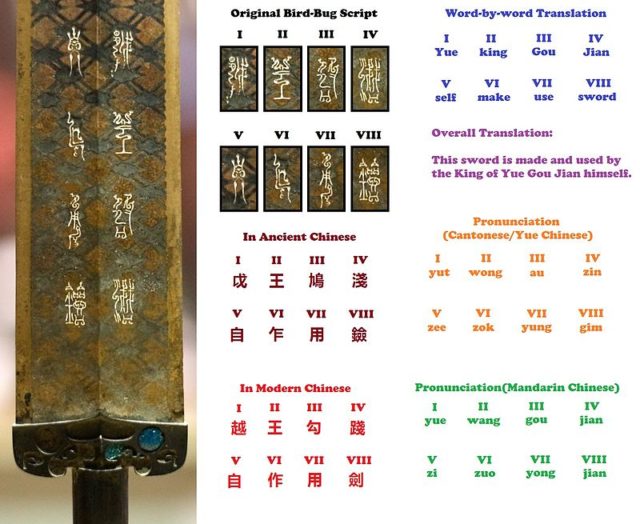This historical artifact of ancient China is currently in the possession of the Hubei Provincial Museum.
In 1965, an archaeological survey was being performed along the second main aqueduct of the Zhang River Reservoir in Jingzhou, Hubei, more than fifty ancient tombs of theChu State were found in Jiangling County. The dig started in the middle of October 1965 and ended in January 1966.
More than 2,000 artifacts were recovered from the sites, including a bronze sword. In December 1965, 7 kilometres (4.3 mi) from the ruins of Jinan, an ancient capital of Chu, a casket was discovered at Wangshan site #1. Inside, an ornate bronze sword was found with a human skeleton.

On one side of the blade, two columns of text are visible. Eight characters are written in an ancient script which was found to be one known as Bird-worm seal script (literally “birds and worms characters” owing to the intricate decorations of the defining strokes), a variant of seal script. Initial analysis of the text deciphered six of the characters, “King of Yue”and “made this sword for [his] personal use”. The remaining two characters were probably the name of this King of Yue.

The discussion was carried out mostly in letters, and it involved famous scholars such as Guo Moruo. After more than two months, the experts started to form a consensus that the original owner of the sword was Goujian, the King of Yue made famous by his perseverance in time of hardship. So the entirety of the text reads “[Belonging to] King Goujian of Yue, made for [his] personal use”.
Construction
The sword of Goujian is 55.6 centimetres (21.9 in) in length, including an 8.4 centimetres (3.3 in) hilt; the blade is 4.6 centimetres (1.8 in) wide at its base. The sword weighs 875 grams (30.9 oz). In addition to the repeating dark rhombi pattern on both sides of the blade, there are decorations of blue crystals and turquoise. The grip of the sword is bound by silk, while the pommel is composed of eleven concentric circles.Chemical composition
The Sword of Goujian still has a sharp blade and shows no signs of tarnish. To understand why, scientists at Fudan University and CAS used modern equipment to determine the chemical composition of the sword, as shown in the table below.It is likely that the chemical composition, along with the almost air-tight scabbard, led to the exceptional state of preservation.The body of the blade is mainly made of copper, making it more pliant and less likely to shatter; the edges have more tin content, making them harder and capable of retaining a sharper edge; the sulfur decreases the chance of tarnish in the patterns.

Δεν υπάρχουν σχόλια:
Δημοσίευση σχολίου